
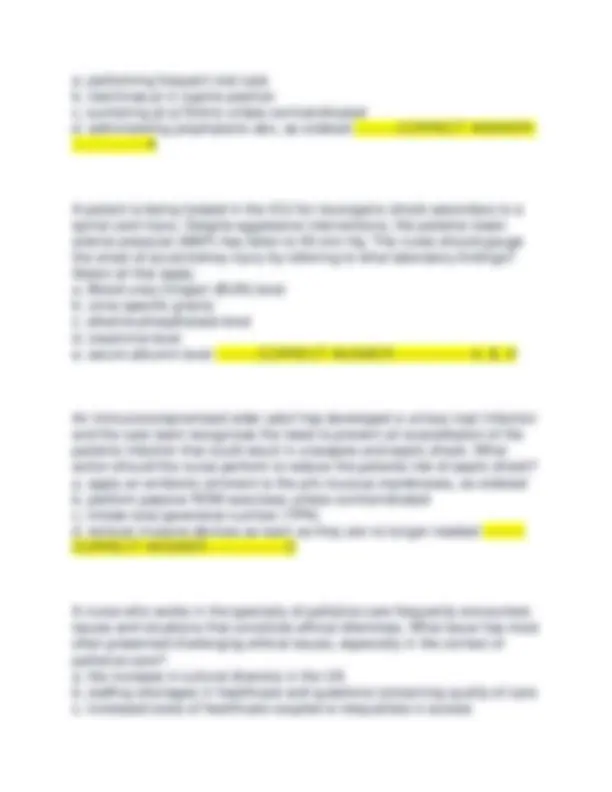
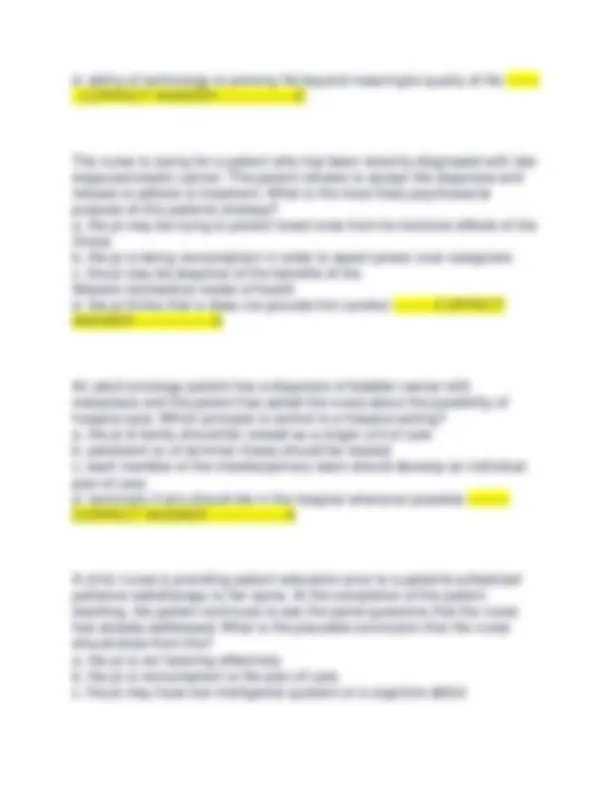
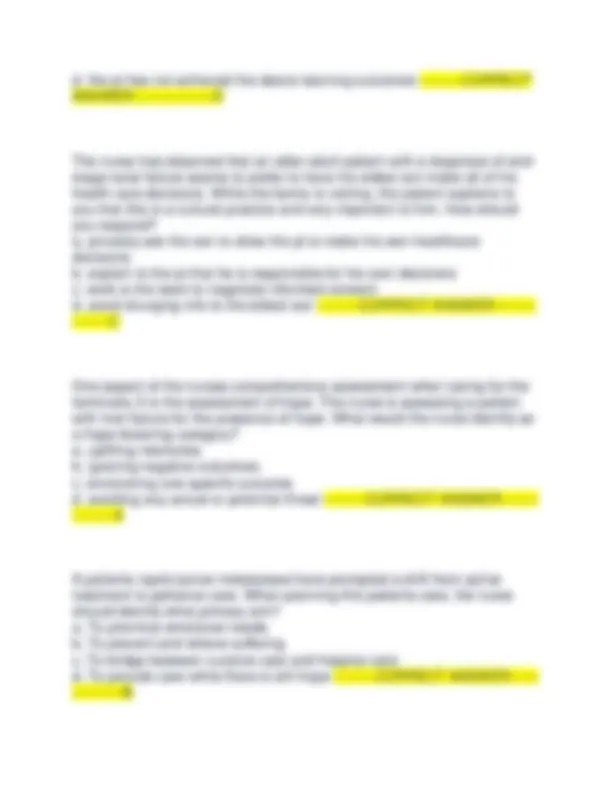
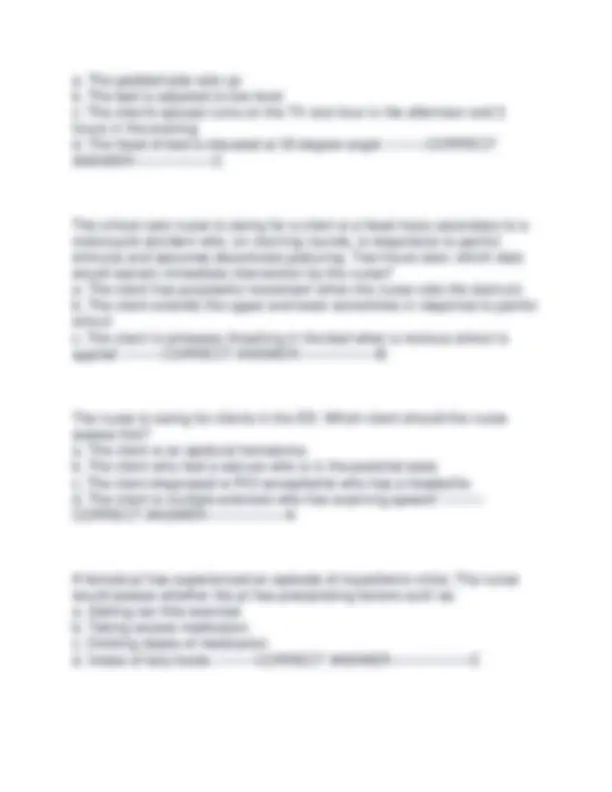

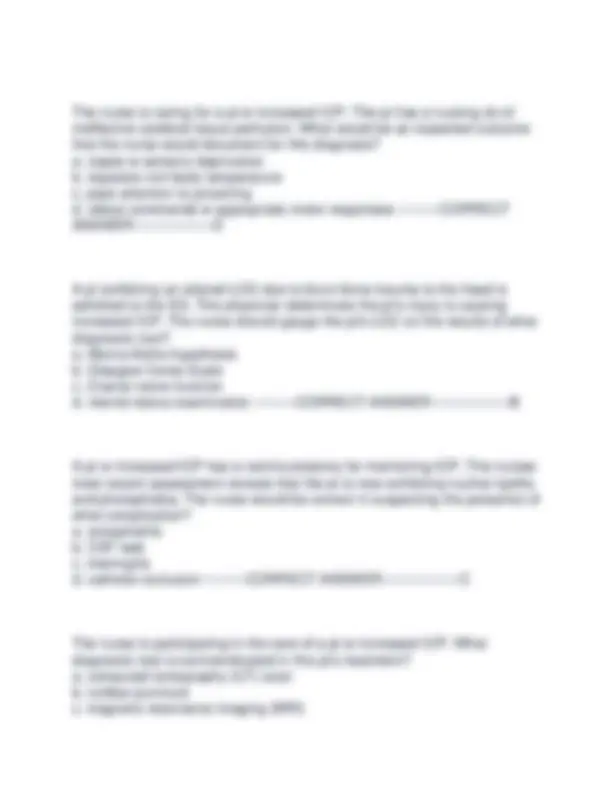
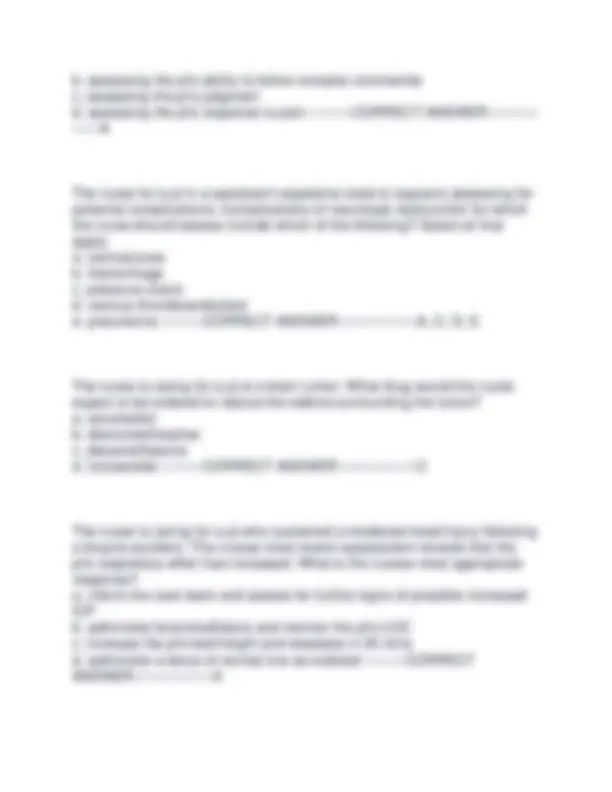
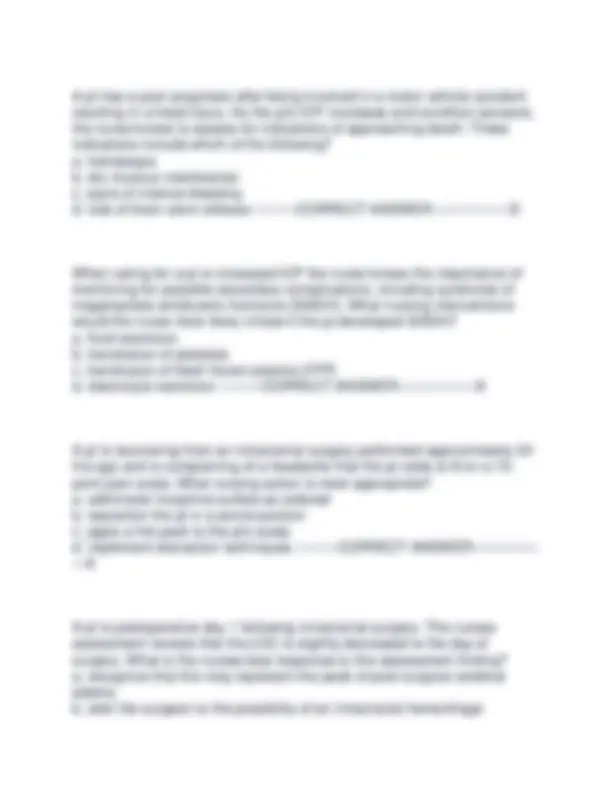
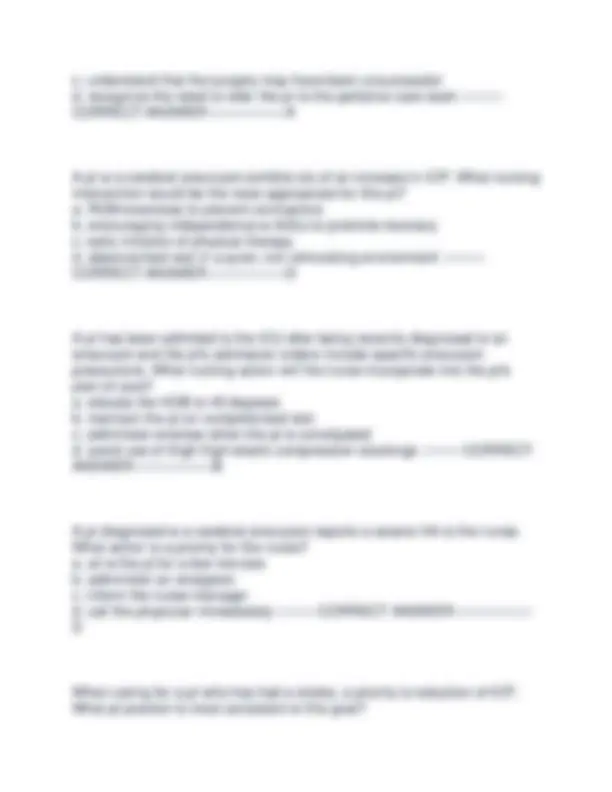
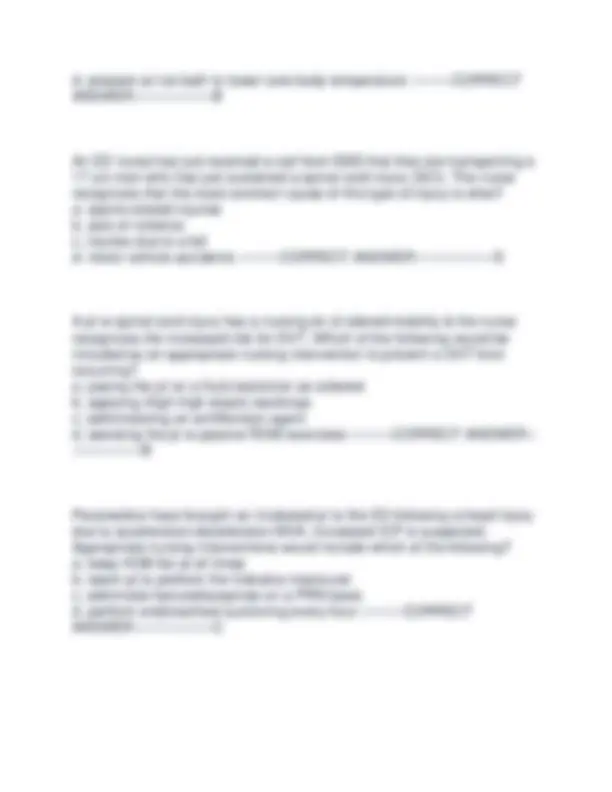
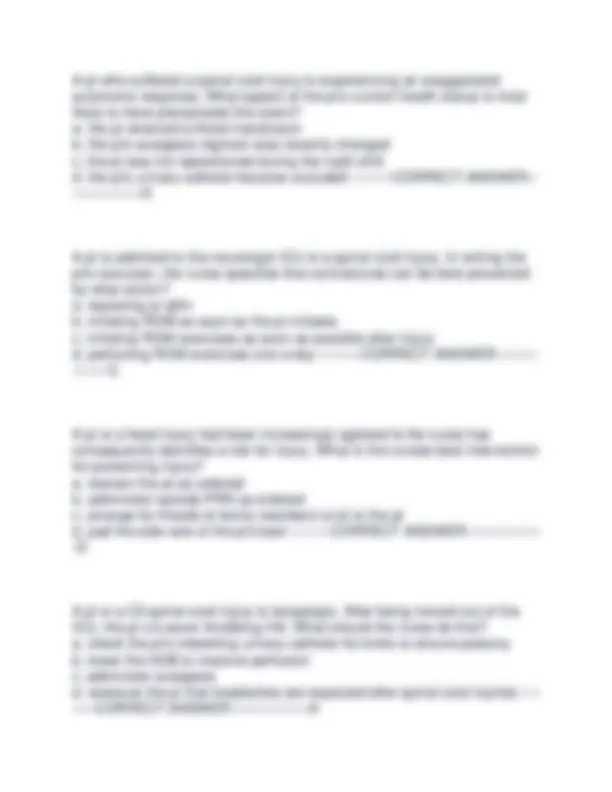
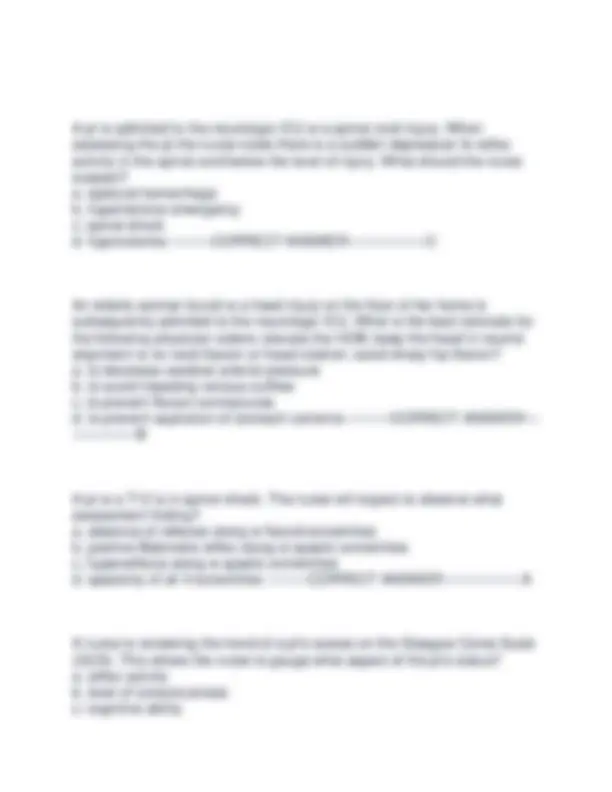
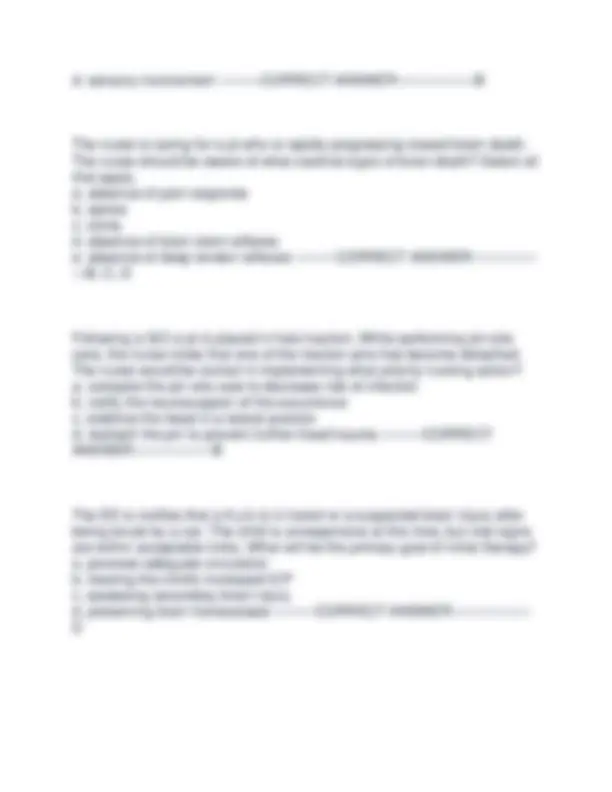
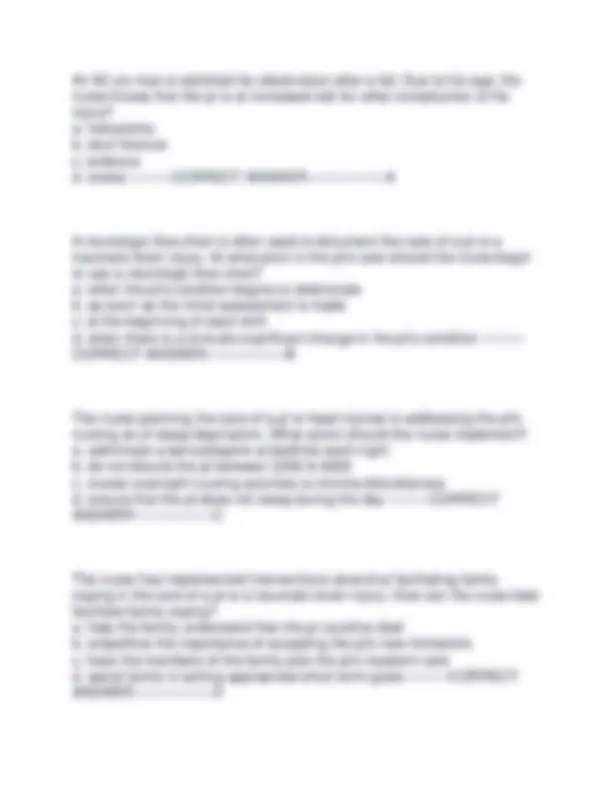
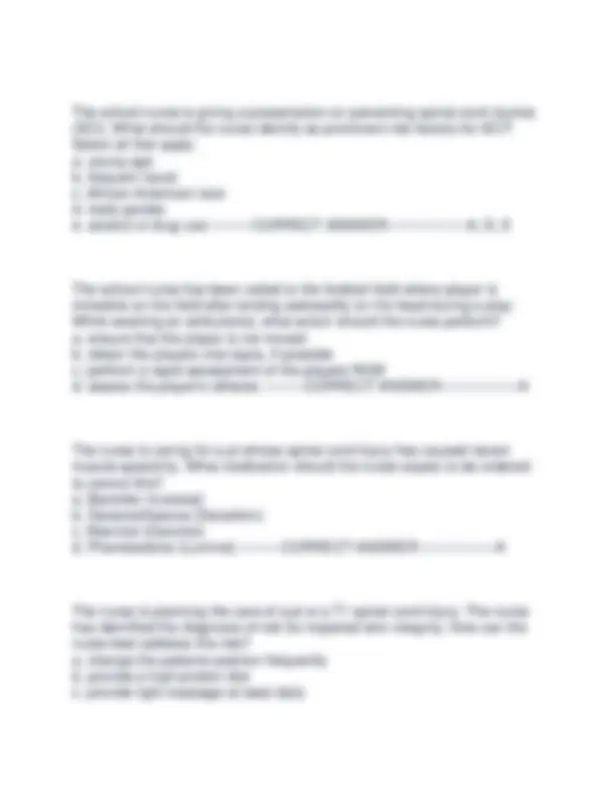
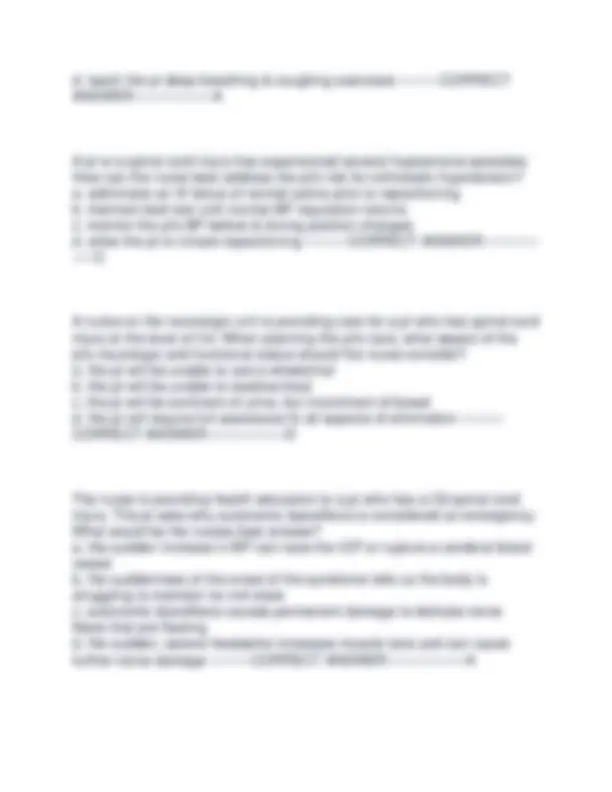
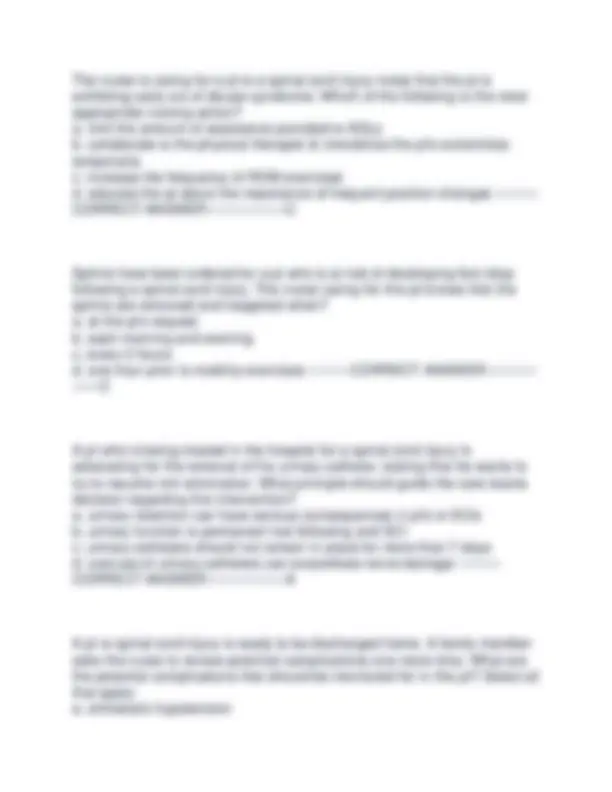
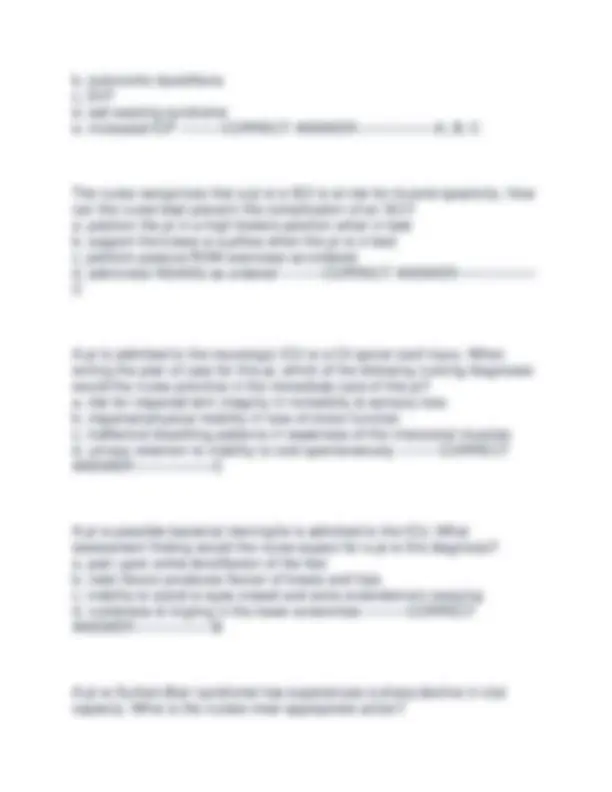
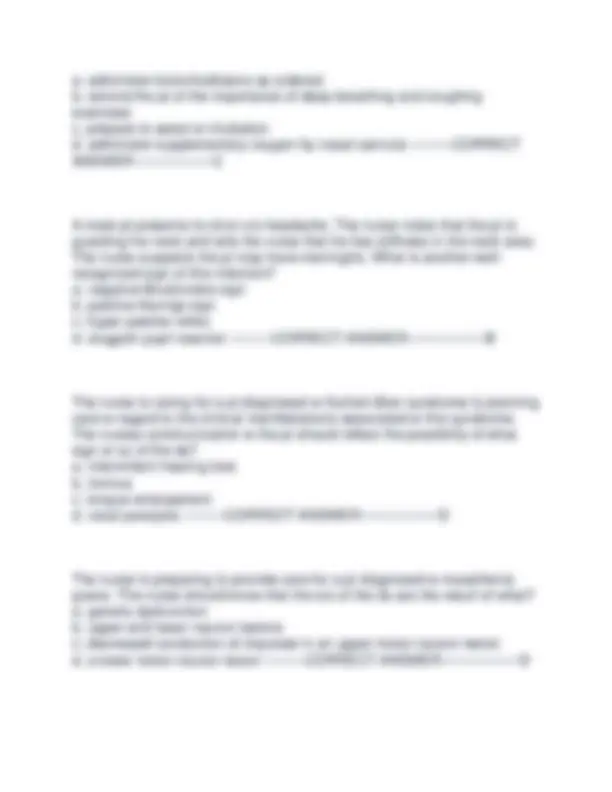
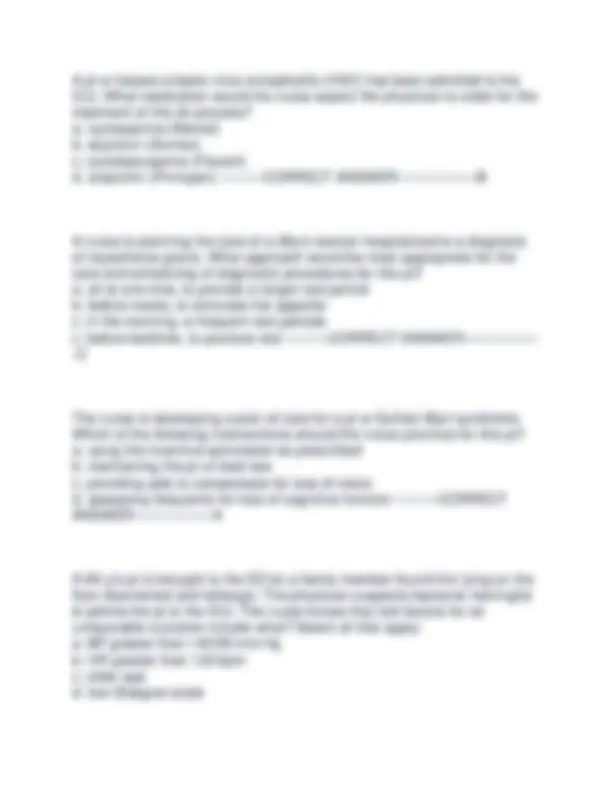
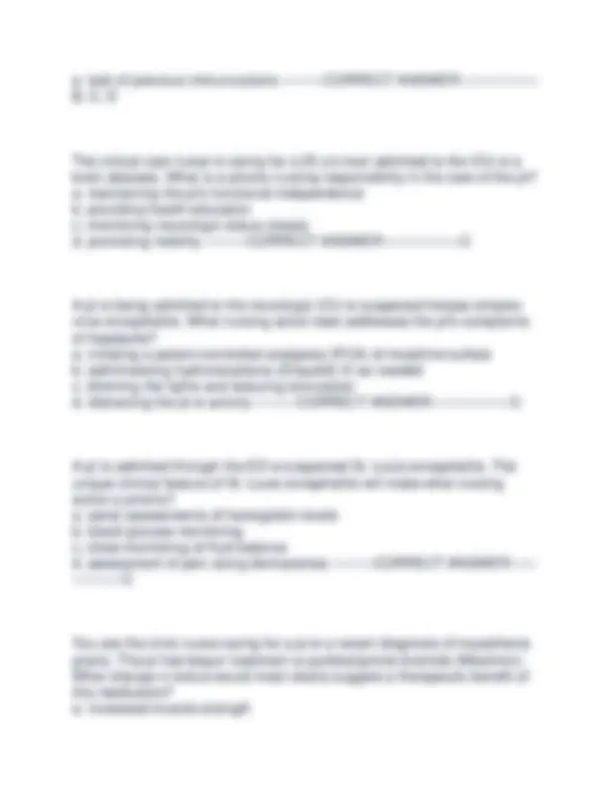
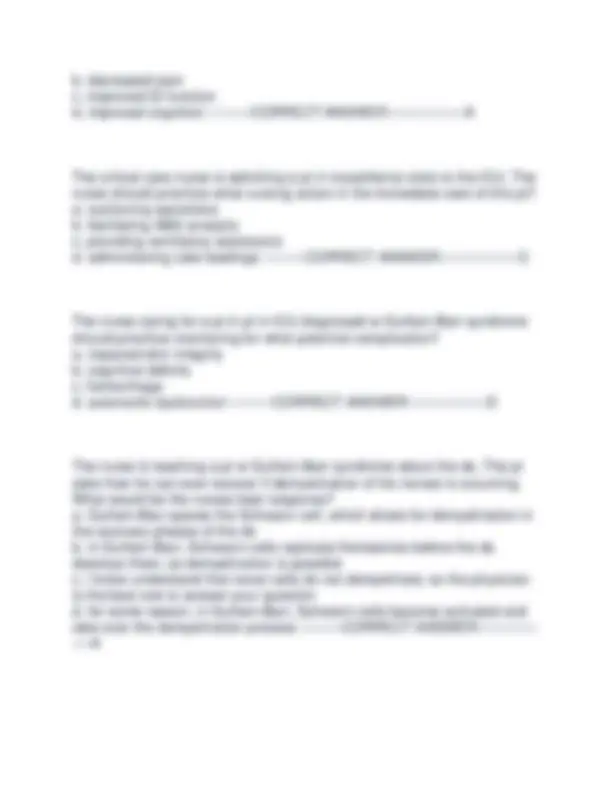
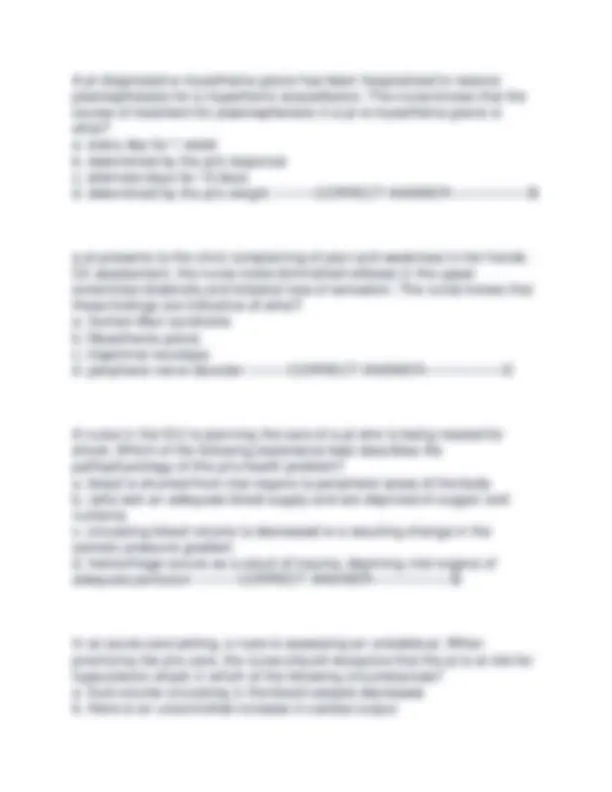
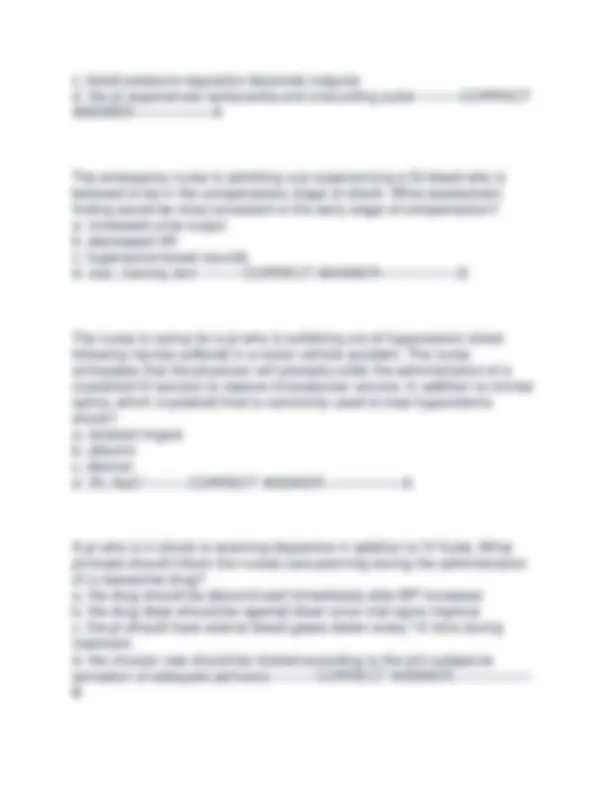
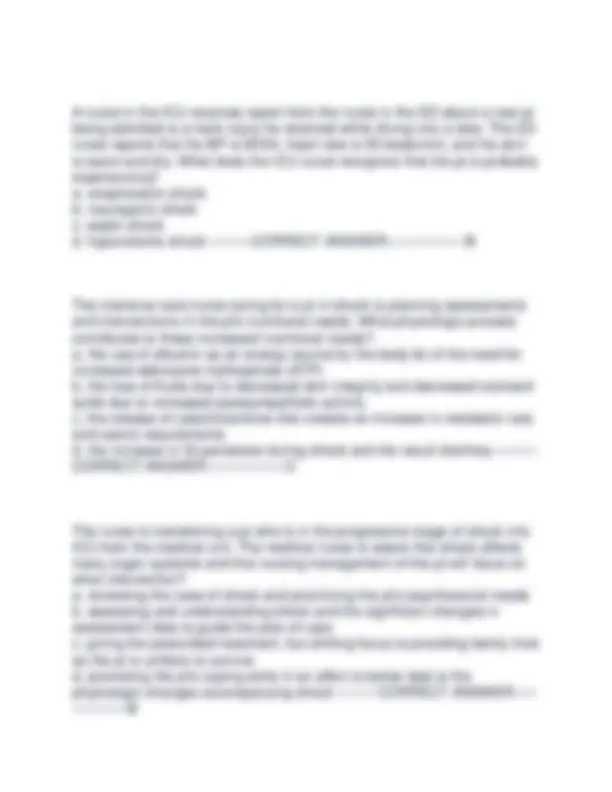
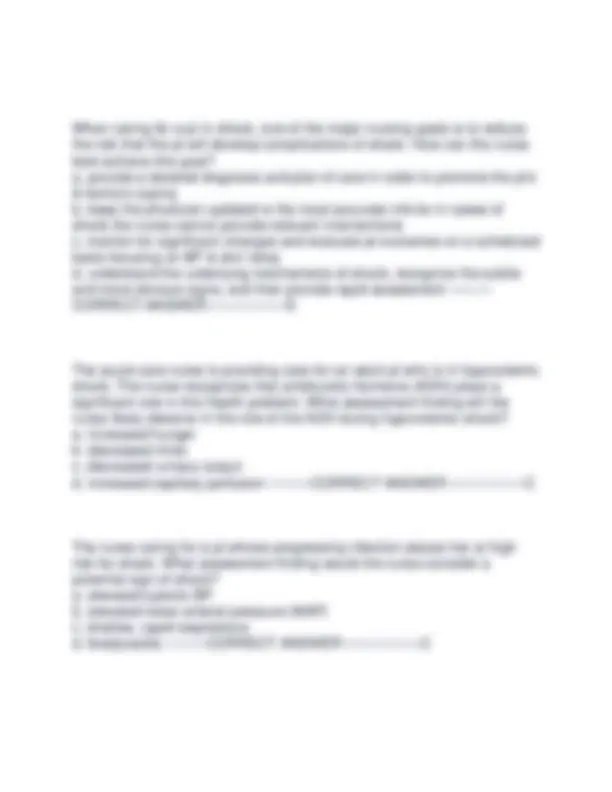
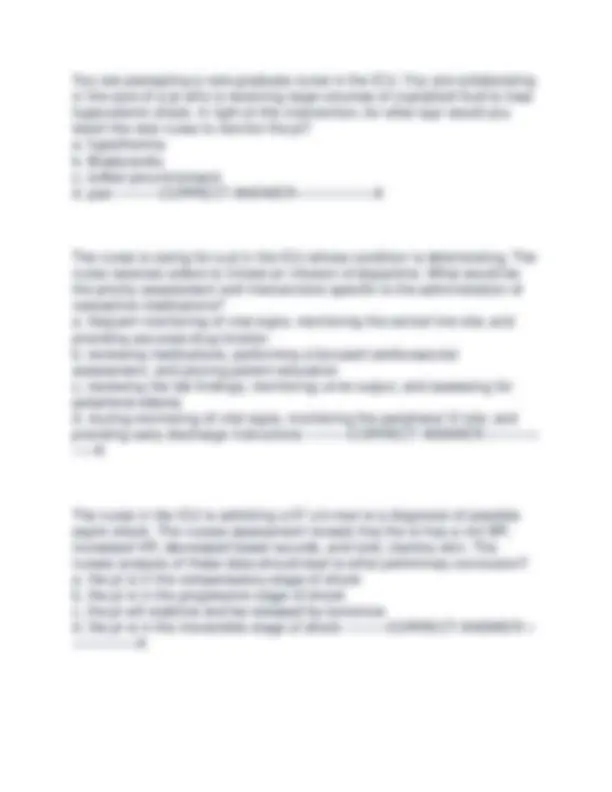
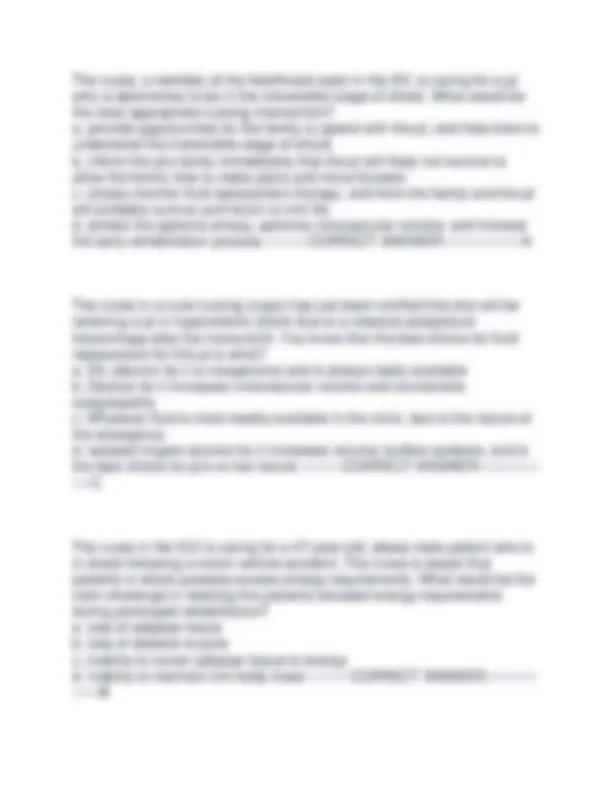
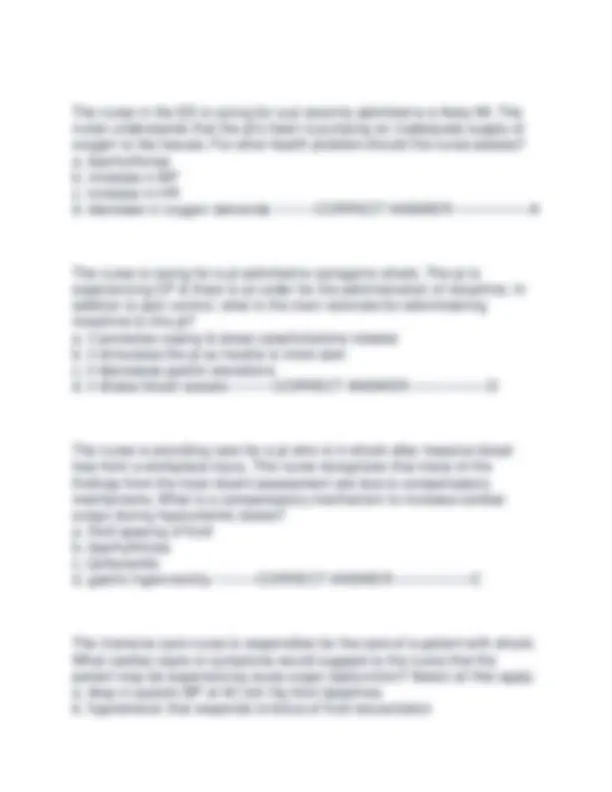
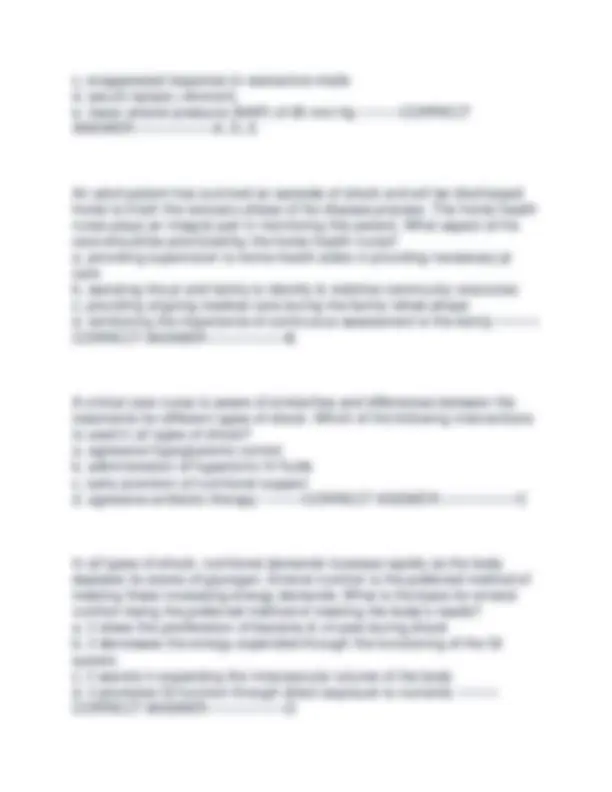
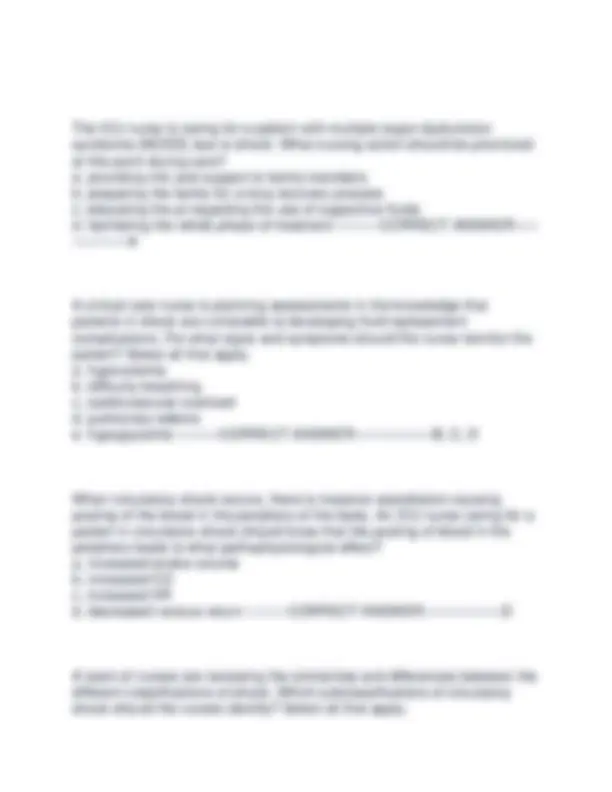

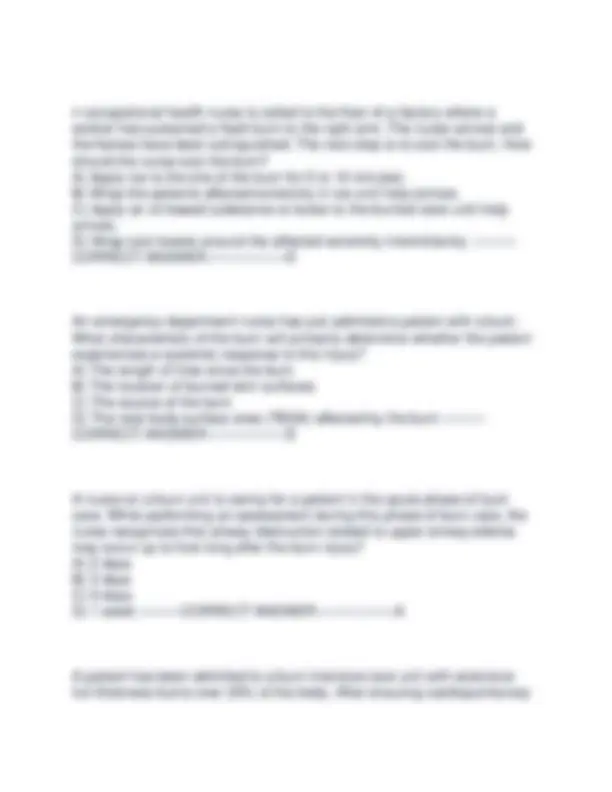
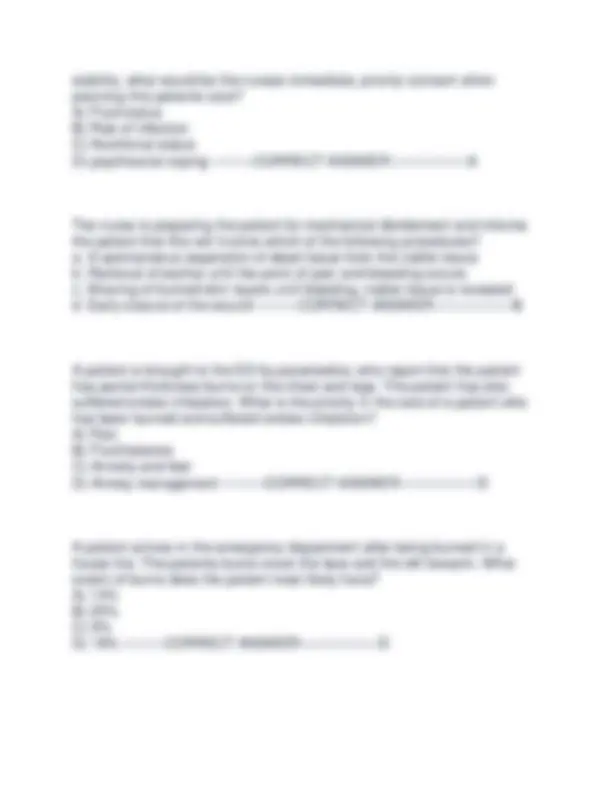
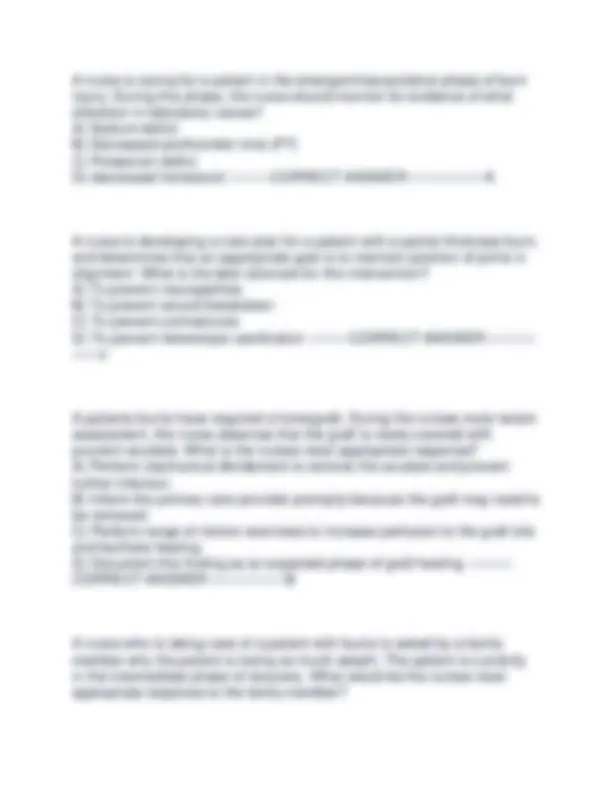
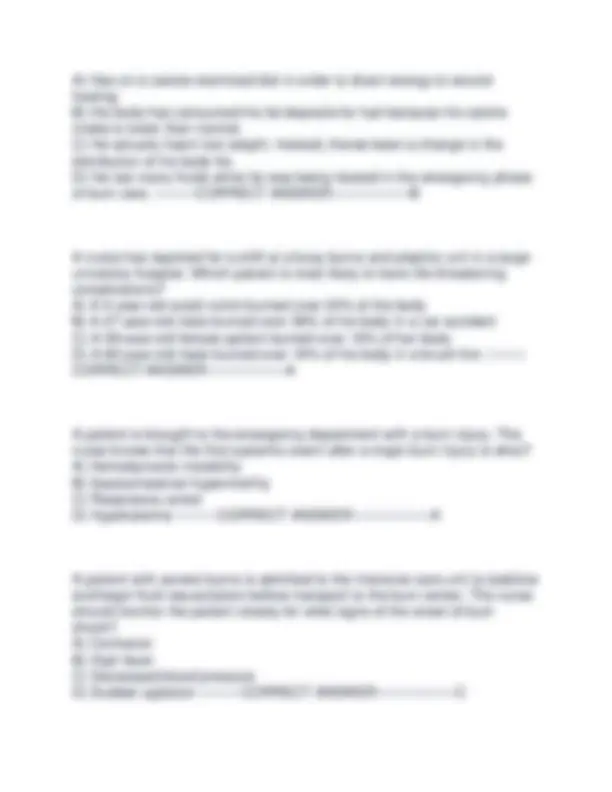
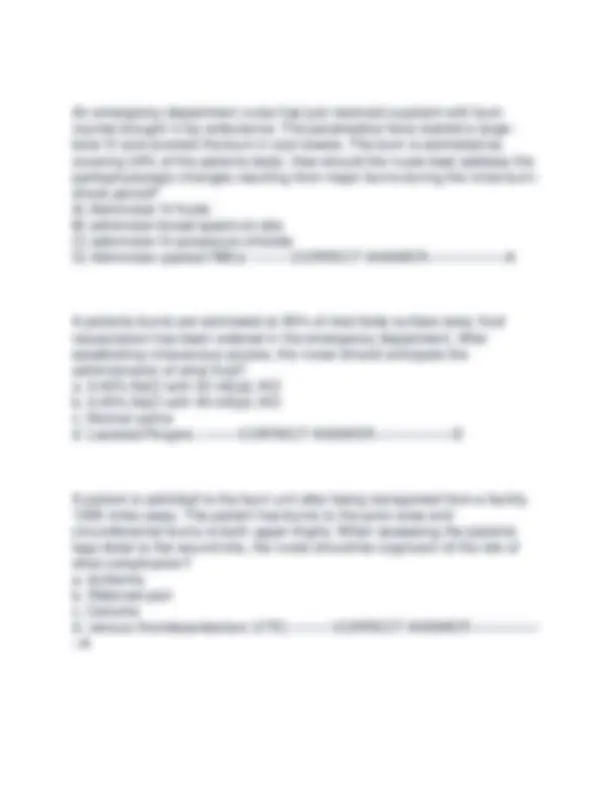
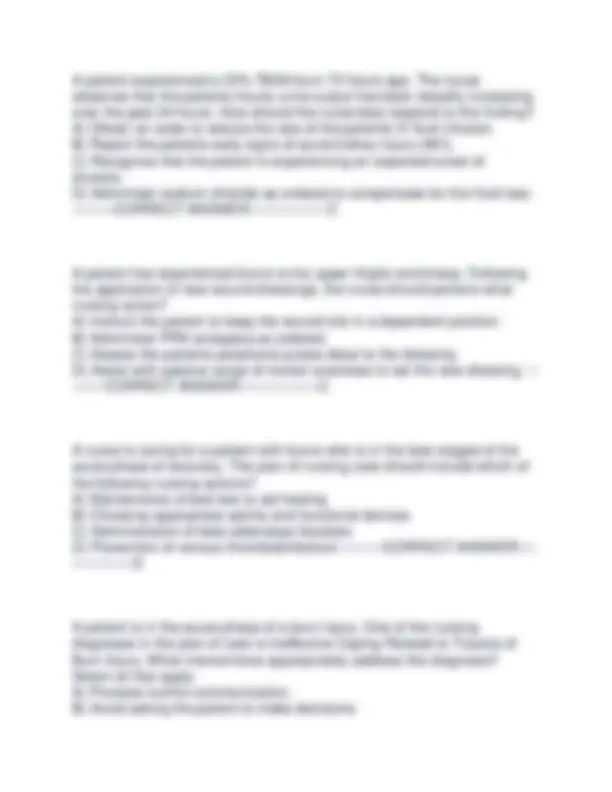
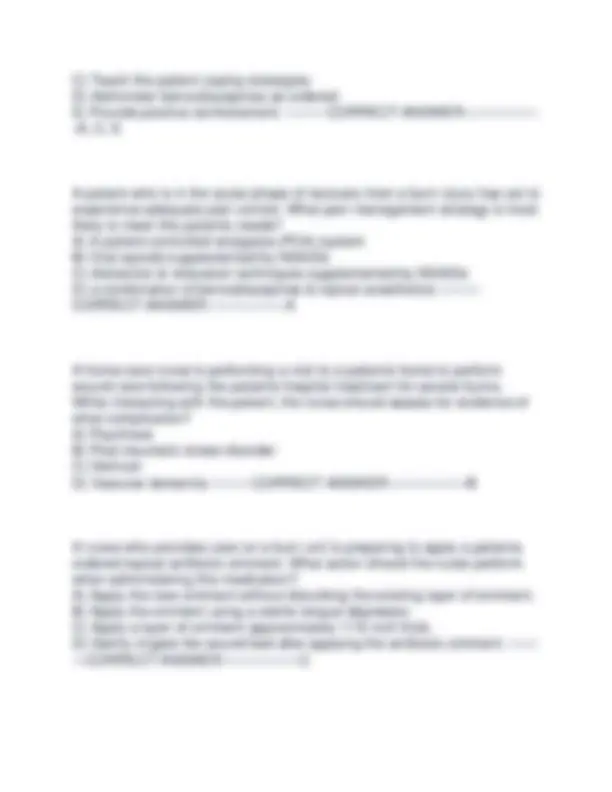
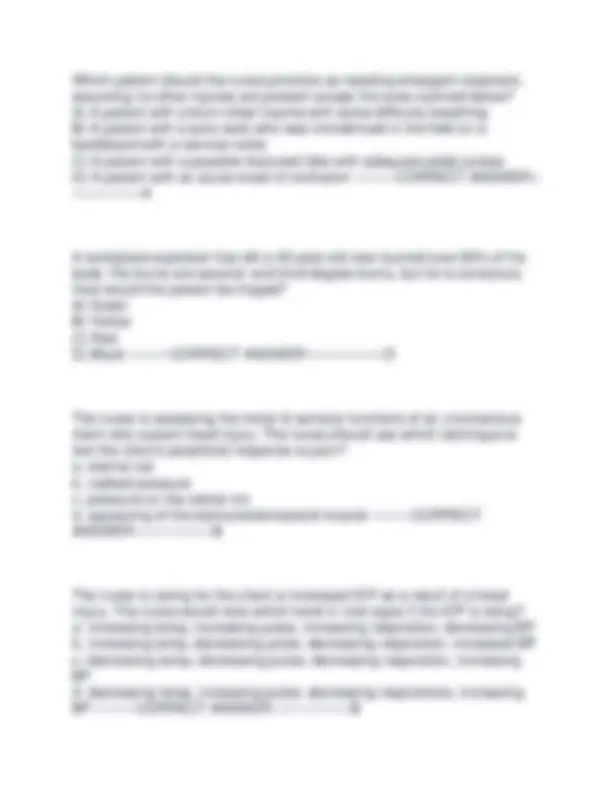
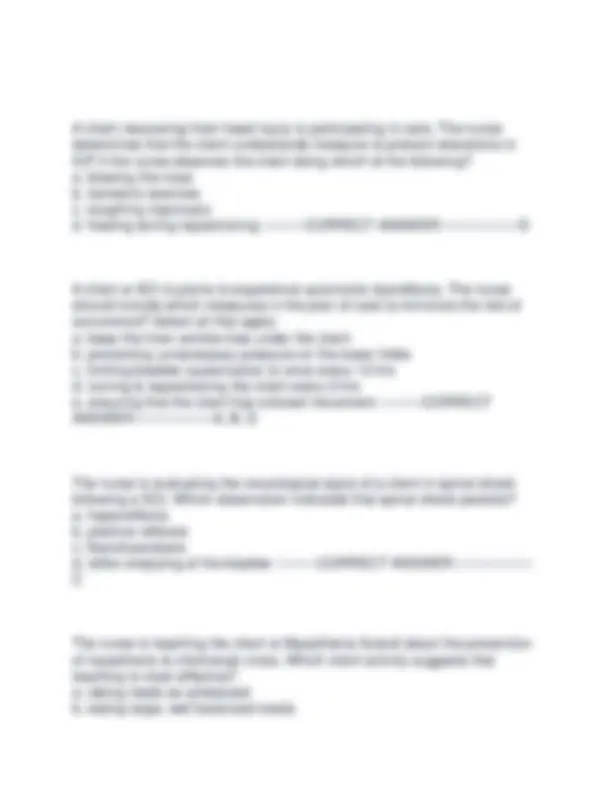
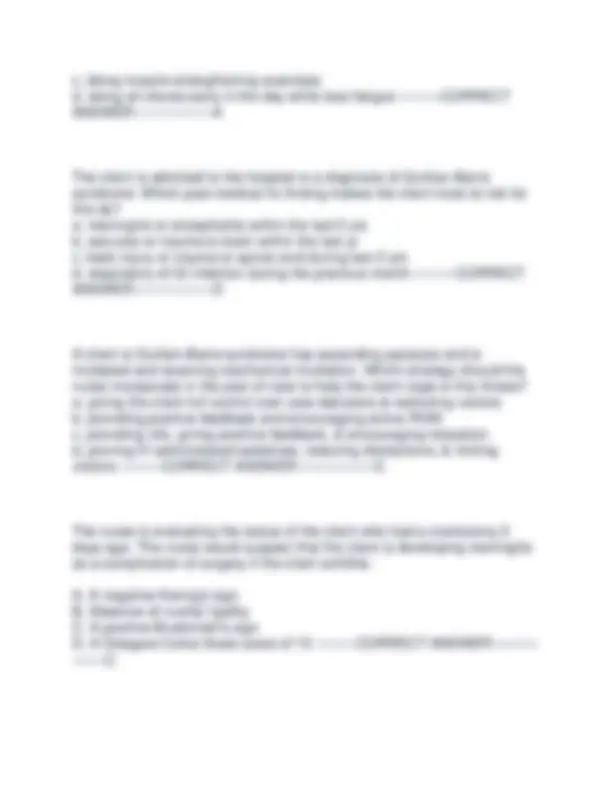
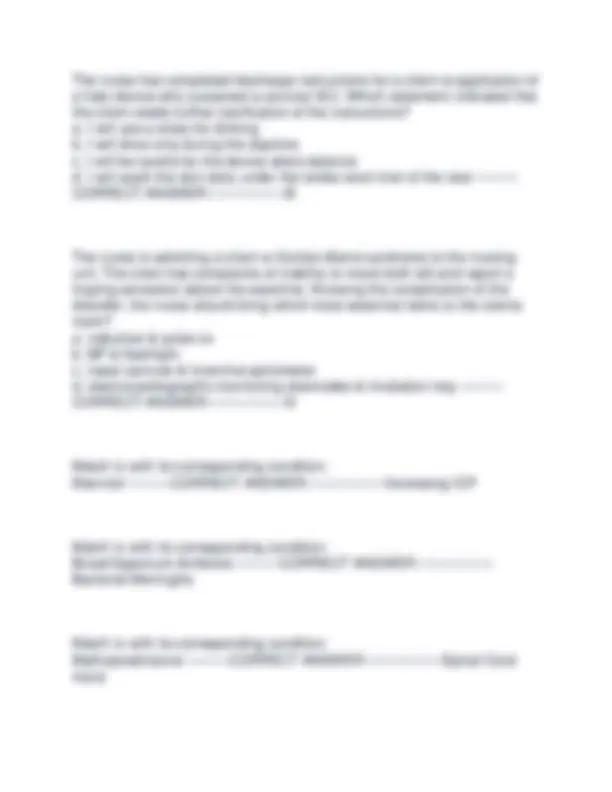
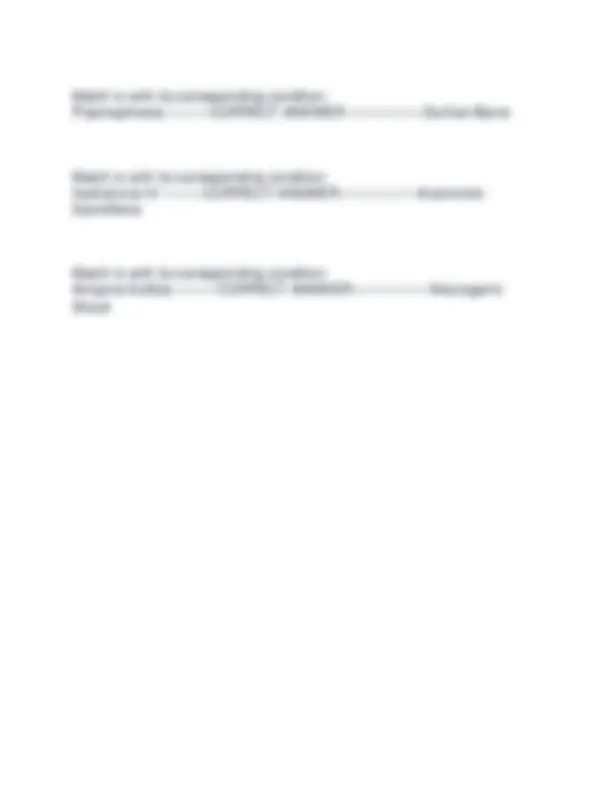


Study with the several resources on Docsity

Earn points by helping other students or get them with a premium plan


Prepare for your exams
Study with the several resources on Docsity

Earn points to download
Earn points by helping other students or get them with a premium plan
Community
Ask the community for help and clear up your study doubts
Discover the best universities in your country according to Docsity users
Free resources
Download our free guides on studying techniques, anxiety management strategies, and thesis advice from Docsity tutors
NSG 4100 EXAM 4 NEWEST EXAM 2025 | ALL QUESTIONS AND CORRECT ANSWERS | ALREADY GRADED A+ | VERIFIED ANSWERS | LATEST EXAM | JUST RELEASED
Typology: Exams
1 / 52

This page cannot be seen from the preview
Don't miss anything!













































A triage nurse in the ED is on shift when a grandfather carries his 4-year- old grandson into the ED. The child is not breathing, and the grandfather states the boy was stung by a bee in a nearby park while they were waiting for the boys mother to get off work. Which of the following would lead the nurse to suspect that the boy is experiencing anaphylactic shock? a. rapid onset of acute hypertension b. rapid onset of respiratory distress c. rapid onset of neurologic compensation d. rapid onset of cardiac arrest ---------CORRECT ANSWER-----------------B The ICU nurse is caring for a patient in neurogenic shock following an overdose of antianxiety medication. When assessing this patient, the nurse should recognize what characteristic of neurogenic shock? a. HTN b. cool, moist skin c. bradycardia d. signs of sympathetic stimulation ---------CORRECT ANSWER--------------- --C The critical care nurse is preparing to initiate an infusion of a vasoactive medication to a patient in shock. The nurse knows that vasoactive medications are given in all forms of shock. What is the primary goal of this aspect of treatment? a. to prevent the formation of infarcts of emboli b. to limit stroke volume & cardiac output c. to prevent pulmonary & peripheral edema d. to maintain adequate mean arterial pressure ---------CORRECT ANSWER-----------------D
The ICU nurse caring for a patient in shock is administering vasoactive medications as per orders. The nurse should know that vasoactive medications should be administered in what way? a. through a central venous line b. by a gravity infusion IV set c. by IV push for rapid onset of action d. mixed w parenteral feedings to balance osmosis ---------CORRECT ANSWER-----------------A The ICU nurse is caring for a patient in hypovolemic shock following a postpartum hemorrhage. For what serious complication of treatment should the nurse monitor the patient? a. anaphylaxis b. decreased oxygen consumption c. abdominal compartment syndrome d. decreased serum osmolality ---------CORRECT ANSWER-----------------C A patient is responding poorly to interventions aimed at treating shock and appears to be transitioning to the irreversible stage of shock. What action should the intensive care nurse include during this phase of the patients care? a. communicate clearly & frequently w the pt's family b. taper down interventions slowly when the prognosis worsens c. transfer the pt to a subacute unit when recovery appears unlikely d. ask the pt's family how they would prefer treatment to proceed --------- CORRECT ANSWER-----------------A A critical care nurse is aware of the high incidence of ventilator-associated pneumonia (VAP) in patients who are being treated for shock. What intervention should be specified in the patients plan of care while the patient is ventilated?
d. ability of technology to prolong life beyond meaningful quality of life ------- --CORRECT ANSWER-----------------D The nurse is caring for a patient who has been recently diagnosed with late stage pancreatic cancer. The patient refuses to accept the diagnosis and refuses to adhere to treatment. What is the most likely psychosocial purpose of this patients strategy? a. the pt may be trying to protect loved ones from he motional effects of the illness b. the pt is being noncompliant in order to assert power over caregivers c. the pt may be skeptical of the benefits of the Western biomedical model of health d. the pt thinks that tx does not provide him comfort ---------CORRECT ANSWER-----------------A An adult oncology patient has a diagnosis of bladder cancer with metastasis and the patient has asked the nurse about the possibility of hospice care. Which principle is central to a hospice setting? a. the pt & family should be viewed as a single unit of care b. persistent sx of terminal illness should be treated c. each member of the interdisciplinary team should develop an individual plan of care d. terminally ill pt's should die in the hospital whenever possible --------- CORRECT ANSWER-----------------A A clinic nurse is providing patient education prior to a patients scheduled palliative radiotherapy to her spine. At the completion of the patient teaching, the patient continues to ask the same questions that the nurse has already addressed. What is the plausible conclusion that the nurse should draw from this? a. the pt is not listening effectively b. the pt is noncompliant w the plan of care c. the pt may have low intelligence quotient or a cognitive deficit
d. the pt has not achieved the desire learning outcomes ---------CORRECT ANSWER-----------------D The nurse has observed that an older adult patient with a diagnosis of end- stage renal failure seems to prefer to have his eldest son make all of his health care decisions. While the family is visiting, the patient explains to you that this is a cultural practice and very important to him. How should you respond? a. privately ask the son to allow the pt to make his own healthcare decisions b. explain to the pt that he is responsible for his own decisions c. work w the team to negotiate informed consent d. avoid divulging info to the eldest son ---------CORRECT ANSWER--------- --------C One aspect of the nurses comprehensive assessment when caring for the terminally ill is the assessment of hope. The nurse is assessing a patient with liver failure for the presence of hope. What would the nurse identify as a hope-fostering category? a. uplifting memories b. ignoring negative outcomes c. envisioning one specific outcome d. avoiding any actual or potential threat ---------CORRECT ANSWER-------- ---------A A patients rapid cancer metastases have prompted a shift from active treatment to palliative care. When planning this patients care, the nurse should identify what primary aim? a. To prioritize emotional needs b. To prevent and relieve suffering c. To bridge between curative care and hospice care d. To provide care while there is still hope ---------CORRECT ANSWER------ -----------B
A patient is brought to the emergency department from the site of a chemical fire, where he suffered a burn that involves the epidermis, dermis, and the muscle and bone of the right arm. On inspection, the skin appears charred. Based on these assessment findings, what is the depth of the burn on the patients arm? A) Superficial partial-thickness B) Deep partial-thickness C) Full partial-thickness D) Full-thickness ---------CORRECT ANSWER-----------------D The pt w fibromyalgia is suffering from pain at 12 of the 18 identification sites, including the neck & upper back & knees. The pt also reports non- refreshing sleep, depression, & being anxious when dealing w multiple tasks. The nurse should teach this pt about what treatments? Select all that apply: a. Minimal aerobic exercise b. Relaxation strategy (biofeedback) c. Anti-seizure during phenytoin d. Serotonin reuptake inhibitor (e.g. sertraline) e. Establish a regular sleep pattern ---------CORRECT ANSWER--------------- --B, D, E The nurse caring for a client w a head injury would recognize which assessment finding as early signs of increased ICP? Select all that apply: a. Kussmaul breathing b. Projectile vomiting c. Weakness in one extremity d. Headache not aggravated by movement of straining e. Decreased urine output f. Papilledema ---------CORRECT ANSWER-----------------A, C, D A nurse caring for a client diagnosed to have head injury. Which of the following situations needs intervention by the nurse?
a. The padded side rails up b. The bed is adjusted to low level c. The client's spouse turns on the TV one hour in the afternoon and 3 hours in the evening d. The head of bed is elevated at 30 degree angle ---------CORRECT ANSWER-----------------C The critical care nurse is caring for a client w a head injury secondary to a motorcycle accident who, on morning rounds, is responsive to painful stimulus and assumes decorticate posturing. Two hours later, which data would warrant immediate intervention by the nurse? a. The client has purposeful movement when the nurse rubs the sternum b. The client extends the upper and lower extremities in response to painful stimuli c. The client is aimlessly thrashing in the bed when a noxious stimuli is applied ---------CORRECT ANSWER-----------------B The nurse is caring for clients in the ED. Which client should the nurse assess first? a. The client w an epidural hematoma b. The client who had a seizure who is in the postictal state c. The client diagnosed w R/O encephalitis who has a headache d. The client w multiple sclerosis who has scanning speech --------- CORRECT ANSWER-----------------A A female pt has experienced an episode of myasthenic crisis. The nurse would assess whether the pt has precipitating factors such as: a. Getting too little exercise b. Taking excess medication c. Omitting doses of medication d. Intake of fatty foods ---------CORRECT ANSWER-----------------C
The nurse is caring for a pt w increased ICP. The pt has a nursing dx of ineffective cerebral tissue perfusion. What would be an expected outcome that the nurse would document for this diagnosis? a. copes w sensory deprivation b. registers nml body temperature c. pays attention to grooming d. obeys commands w appropriate motor responses ---------CORRECT ANSWER-----------------D A pt exhibiting an altered LOC due to blunt-force trauma to the head is admitted to the ED. The physician determines the pt's injury is causing increased ICP. The nurse should gauge the pt's LOC on the results of what diagnostic tool? a. Monro-Kellie hypothesis b. Glasgow Coma Scale c. Cranial nerve function d. mental status examination ---------CORRECT ANSWER-----------------B A pt w increased ICP has a ventriculostomy for monitoring ICP. The nurses most recent assessment reveals that the pt is now exhibiting nuchal rigidity and photophobia. The nurse would be correct in suspecting the presence of what complication? a. encephalitis b. CSF leak c. meningitis d. catheter occlusion ---------CORRECT ANSWER-----------------C The nurse is participating in the care of a pt w increased ICP. What diagnostic test is contraindicated in this pt's treatment? a. computed tomography (CT) scan b. lumbar puncture c. magnetic resonance imaging (MRI)
d. venous doppler studies ---------CORRECT ANSWER-----------------B The nurse has created a plan of care for a pt who is at risk for increased ICP. The pt's care plan should specify monitoring for what early sign of increased ICP? a. disorientation and restlessness b. decreased pulse and respirations c. projectile vomiting d. loss of corneal reflex ---------CORRECT ANSWER-----------------A The neurologic ICU nurse is admitting a pt following a craniotomy using the supratentorial approach. How should the nurse best position the pt? a. position the pt supine b. maintain HOB elevated at 30-45 degrees c. position pt in prone position d. maintain bed in Trendelenberg position ---------CORRECT ANSWER------ -----------B A pt has developed diabetes insipidness after having increased ICP following head trauma. What nursing assessment best addresses this complication? a. vigilant monitoring of fluid balance b. continuous BP monitoring c. serial arterial blood gases (ABGs) d. monitoring of the pt's airway for patency ---------CORRECT ANSWER----- ------------A What would the nurse suspect when hourly assessment of UO on a pt postcrainiotomy exhibits a urine output from a catheter of 1,500mL for 2 consecutive hours? a. ruching syndrom b. syndrome of inappropriate antidiuretic hormone (SIADH)
b. assessing the pt's ability to follow complex commands c. assessing the pt's judgment d. assessing the pt's response to pain ---------CORRECT ANSWER----------- ------A The nurse for a pt in a persistent vegetative state is regularly assessing for potential complications. Complications of neurologic dysfunction for which the nurse should assess include which of the following? Select all that apply: a. contractures b. hemorrhage c. pressure ulcers d. venous thromboembolism e. pneumonia ---------CORRECT ANSWER-----------------A, C, D, E The nurse is caring for a pt w a brain tumor. What drug would the nurse expect to be ordered to reduce the edema surrounding the tumor? a. solumedrol b. dextromethorphan c. dexamethasone d. furosemide ---------CORRECT ANSWER-----------------C The nurse is caring for a pt who sustained a moderate head injury following a bicycle accident. The nurses most recent assessment reveals that the pt's respiratory effort has increased. What is the nurses most appropriate response? a. inform the care team and assess for further signs of possible increased ICP b. administer bronchodilators and monitor the pt's LOC c. increase the pt's bed height and reassess in 30 mins d. administer a bolus of normal line as ordered ---------CORRECT ANSWER-----------------A
A pt has a poor prognosis after being involved in a motor vehicle accident resulting in a head injury. As the pt's ICP increases and condition worsens, the nurse knows to assess for indications of approaching death. These indications include which of the following? a. hemiplegia b. dry mucous membranes c. signs of internal bleeding d. loss of brain stem reflexes ---------CORRECT ANSWER-----------------D When caring for a pt w increased ICP the nurse knows the importance of monitoring for possible secondary complications, including syndrome of inappropriate antidiuretic hormone (SIADH). What nursing interventions would the nurse most likely initiate if the pt developed SIADH? a. fluid restriction b. transfusion of platelets c. transfusion of fresh frozen plasma (FFP) d. electrolyte restriction ---------CORRECT ANSWER-----------------A A pt is recovering from an intracranial surgery performed approximately 24 hrs ago and is complaining of a headache that the pt rates at 8 on a 10- point pain scale. What nursing action is most appropriate? a. administer morphine sulfate as ordered b. reposition the pt in a prone position c. apply a hot pack to the pt's scalp d. implement distraction techniques ---------CORRECT ANSWER-------------- ---A A pt is postoperative day 1 following intracranial surgery. The nurses assessment reveals that the LOC is slightly decreased w the day of surgery. What is the nurses best response to this assessment finding? a. recognize that this may represent the peak of post-surgical cerebral edema b. alert the surgeon to the possibility of an intracranial hemorrhage
a. head turned slightly to the R side b. elevation of HOB c. position changes q15min while awake d. extension of neck ---------CORRECT ANSWER-----------------B After a subarachnoid hemorrhage, the patient's laboratory results indicate a serum sodium level of less than 126 mEq/L. What is the nurse's most appropriate action a. administer a bolus of normal saline as ordered b. prepare pt for thrombolytic therapy as ordered c. facilitate testing for hypothalamic dysfunction d. prepare to administer 3% NaCl by IV as ordered ---------CORRECT ANSWER-----------------D Following diagnostic testing, a pt has been admitted to the ICU and placed on cerebral aneurysm precautions. What nursing action should be included in pt's plan of care? a. supervise the pt's activities of daily living closely b. initiate early ambulation to prevent complications of immobility c. provide a high-calorie, low-protein diet d. perform all of the pt's hygiene and feeding ---------CORRECT ANSWER-- ---------------A A pt is brought to the trauma center by ambulance after sustaining a high cervical spinal cord injury 1 hour ago. Endotracheal intubation has been deemed necessary and the nurse is preparing to assist. What nursing dx should the nurse associate w this procedure? a. risk for impaired skin integrity b. risk for injury c. risk for autonomic dysreflexia d. risk for suffocation ---------CORRECT ANSWER-----------------B
A nurse is caring for a critically ill pt w autonomic dysreflexia. What clinical manifestations would the nurse expect in this pt? a. respiratory distress & projectile vomiting b. bradycardia & HTN c. tachycardia & agitation d. third-spacing & hyperthermia ---------CORRECT ANSWER-----------------B The nurse is caring for a pt w increased ICP caused by a traumatic brain injury. Which of the following clinical manifestations would suggest that the pt may be experiencing increased brain compression causing brains temp damage? a. hyperthermia b. tachycardia c. HTN d. bradypnea ---------CORRECT ANSWER-----------------A A pt is brought to the ED by her family after falling off the roof. A family member tells the nurse that when the pt fell, she was knocked out, but came back and seemed okay. Now she is c/o a severe HA and not feeling well. The care team suspects an epidural hematoma, prompting the nurse to prepare for which priority intervention? a. insertion of an intracranial monitoring device b. treatment w antihypertensives c. emergency craniotomy d. administration of anticoagulant therapy ---------CORRECT ANSWER------ -----------C The staff educator is precasting a nurse new to the critical care unit when a pt w a T2 spinal cord injury is admitted. The pt is soon exhibiting manifestations of neurogenic shock. In addition to monitoring the pt closely, what would be the nurses most appropriate action? a. prepare to transfuse packed red blood cells b. prepare for interventions to increase the pt's BP c. place the pt in the Trendelenberg position
A pt who suffered a spinal cord injury is experiencing an exaggerated autonomic response. What aspect of the pt's current health status is most likely to have precipitated this event? a. the pt received a blood transfusion b. the pt's analgesia regimen was recently changed c. the pt was not repositioned during the night shift d. the pt's urinary catheter became occluded ---------CORRECT ANSWER-- ---------------D A pt is admitted to the neurologic ICU w a spinal cord injury. In writing the pt's care plan, the nurse specifies that contractures can be best prevented by what action? a. reposting pt q2hr b. initiating ROM as soon as the pt initiates c. initiating ROM exercises as soon as possible after injury d. perfuming ROM exercises one a day ---------CORRECT ANSWER--------- --------C A pt w a head injury had been increasingly agitated & the nurse has consequently identifies a risk for injury. What is the nurses best intervention for preventing injury? a. restrain the pt as ordered b. administer opioids PRN as ordered c. arrange for friends & family members to sit w the pt d. pad the side rails of the pt's bed ---------CORRECT ANSWER----------------
A pt is admitted to the neurologic ICU w a spinal cord injury. When assessing the pt the nurse notes there is a sudden depression fo reflex activity in the spinal cord below the level of injury. What should the nurse suspect? a. epidural hemorrhage b. hypertensive emergency c. spinal shock d. hypovolemia ---------CORRECT ANSWER-----------------C An elderly woman found w a head injury on the floor of her home is subsequently admitted to the neurologic ICU. What is the best rationale for the following physician orders: elevate the HOB; keep the head in neutral alignment w no neck flexion or head rotation; avoid sharp hip flexion? a. to decrease cerebral arterial pressure b. to avoid impeding venous outflow c. to prevent flexion contractures d. to prevent aspiration of stomach contents ---------CORRECT ANSWER--- --------------B A pt w a T12 is in spinal shock. The nurse will expect to observe what assessment finding? a. absence of reflexes along w flaccid extremities b. positive Babinskis reflex along w spastic extremities c. hyperreflexia along w spastic extremities d. spasticity of all 4 extremities ---------CORRECT ANSWER-----------------A A nurse is reviewing the trend of a pt's scores on the Glasgow Coma Scale (GCS). This allows the nurse to gauge what aspect of the pt's status? a. reflex activity b. level of consciousness c. cognitive ability